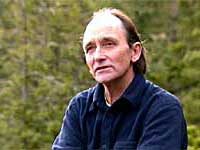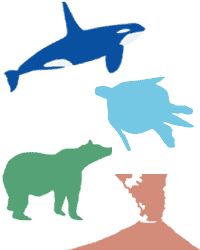| About this Site |
| Foreword Dr. Paul Spong has devoted the past 30 years to researching wild orcas in their natural habitat. One night some twenty years ago--when the ocean was still and a full moon lit the sky--Dr. Spong heard the breath of the passing orcas. He felt that if only the whole world could share this moment, it would surely change people's sense of the world. This moment inspired the concept of the Nature Network: stations set up in Nature that transmit live images and sound to people around the world. Implementing the concept, which at the time was technically very difficult, becomes much more feasible with the widespread use of the Internet. This site has been conducting a variety of experiments since 2000 towards realizing Nature Network. |

|
| What is Nature Network? The idea of Nature Network is to relay live imagery and sound from cameras set up in Nature throughout the world. "My hope is to bring people closer to Nature without disrupting her" --that hope is the hope of Dr. Spong. (Please read the "Message for OrcaLive by Paul Spong.") At this very moment, all over the world, a variety of organisms are beaming with life. Wouldn't it be wonderful if there were media by which people could get a sense of this? If a window could be opened up that would trigger city dwellers' memories of the rhythms of Nature, the way we sense the world and our way of being are bound to change somewhat. That hope, too, lies within. |
 |
| About Dr. Paul Spong Born in New Zealand in 1939. Postgraduate work on the brain functions at UCLA. Began researching orcas at Vancouver Aquarium. Sensing the need to study orcas not in captivity, but living unbound in their natural habitat, he established OrcaLab in 1970 on (then) uninhabited Hanson Island near Vancouver Island, Canada. He has since spent more than 30 years researching the ecology of wild orcas. |
 |
| The Summer Live Experiments However widespread Internet use may have become, linking places in Nature not accessible to telephone wiring to the Net remains a difficult task. Exposing Nature to negative effects, however, would be a far greater loss. So addressing these problems one by one, we set out to conduct the experiment. The year 2000 marked the start of an experiment bringing the world the live voices and images of orcas via six hydrophones and five cameras (four underwater) off Hanson Island, the home of Dr. Paul Spong. (See "Behind the scenes" for highlights of the installation in July 2000.) The aim of the experiment, of course, is not only technological. Your thoughts and opinions of the experience will also form a critical part of the experiment results that determine the future of the project. This Summer Live Project is scheduled to open in July. We strongly encourage you to participate in Nature Network. |
    |
| The Aim of this Project While one of our specific aims is to relay live sound and images of the orcas in the natural environment of Hanson Island, we are presently groping to find the most appropriate form for presenting Nature Network via the Internet. Relaying live sound/images from the waters of Canada will start the ball rolling, with the aim of adding new Nature Network bases in natural environments the world over. We envision Nature Network extending beyond the computer screen, working in tandem with permanent installations and/or events, serving as an environmental/science education tool. Nature Network Project http://www.NatureNetwork.net/ |

|